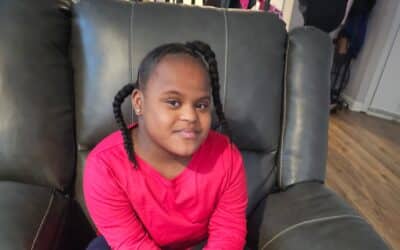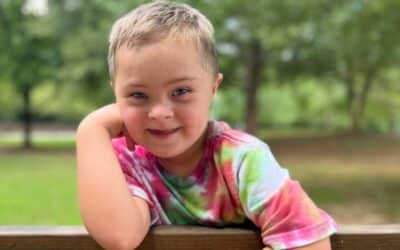Expressive language is what we most often think about when we describe a child’s language development. It is what we usually refer to as “talking.” This article will explain, “What is expressive language development?” It will also offer examples and provide resources for parents. The milestones shared can be applied to a child’s chronological as well as their developmental age level.
Expressive Language Defined
Expressive language is the use of words, symbols, signs, gestures, and writing to convey messages and information to others. It’s an essential aspect of a child’s communication, cognitive, and social growth, enabling them to share their needs, wants, feelings, and ideas with the world around them. Expressive language develops over the course of a lifetime, and it follows fairly predictable progression.
Examples of Expressive Language Milestones
Development often happens in phases marked by milestones. The order of these phases is as important, if not more important that their timing. The milestones shared below give a broad overview of the development of expressive language skills from infancy through five years of age.

Birth to 3 Months
- Coos and makes pleasure sounds
- Cries differently for different needs
- Smiles when sees you
4 to 6 Months
- Babbles with different sounds (e.g., “bababa”)
- Laughs
- Babbles when excited or unhappy
- Makes gurgling sounds when alone or playing
7 Months to 1 Year
- Babbling has both long and short groups of sounds (e.g., “tata upup bibibibi”)
- Uses speech or non-crying sounds to get and keep attention
- Imitates different speech sounds
- Has one or two words (such as, hi, dog, dada, mama) by first birthday, although sounds may not be clear

1 to 2 Years
- Says more words every week
- Uses some one- or two-word questions (“Where kitty?” “Go bye-bye?”)
- Puts two words together (“more cookie,” “no juice,” “mommy book”)
- Uses many different consonant sounds at the beginning of words
2 to 3 Years
- Has a word for almost everything
- Uses two- or three-word phrases to talk about and ask for things
- Speech is understood by familiar listeners most of the time
- Often asks for or directs attention to objects by naming them
3 to 4 Years
- Talks about prior activities and experiences
- People outside of the family usually understand child’s speech
- Uses sentences that have four or more words
- Usually talks easily without repeating syllables or words

4 to 5 Years
- Says all speech sounds in words. May make mistakes on some harder sounds, like l, s, r, v, z, ch, sh, th
- Responds to “What did you say?”
- Uses sentences that give lots of details
- Tells stories that stick to a topic
FAQs:
1. What’s the difference between expressive and receptive language?
- Expressive language is about output – how your child conveys their needs, wants, feelings, and ideas. In contrast, receptive language concerns input – how your child understands language.
2. How can I support my child’s expressive language development?
- Respond to your child’s communication efforts including their facial expressions, gestures, vocalizations, signs, use of pictures, and words.
- Model language and talk with your child throughout their daily routine.
- Point to, label, explore, and describe important words.
- Share books and read together daily.
- Interact during play and add language and turn taking.
- Create a language-rich environment at home.
3. My child seems behind in expressive language. Should I be worried?
- No need to worry. If you’re concerned about your child’s expressive language or any aspect of their communication development, consult with a pediatric speech-language pathologist.
Additional Resources:
- Language In Brief (asha.org)
- Communication Milestones: Age Ranges (asha.org)
- Hanen’s Four Stages of Early Communication: A Short Guide for Parents
- Language Development Domain – Child Development (CA Dept of Education)
Summary/Conclusion:
By understanding and nurturing your child’s expressive language development, you lay the groundwork for their communication, academic, and social growth. Your efforts will impact them now as well as in the future. Tailoring your approach to your child’s unique strengths, interests, and needs and consistently engaging in positive communication experiences can significantly enhance their language expression and confidence. Language development is a wonderful journey of discovery and connection. Enjoy every moment.




0 Comments